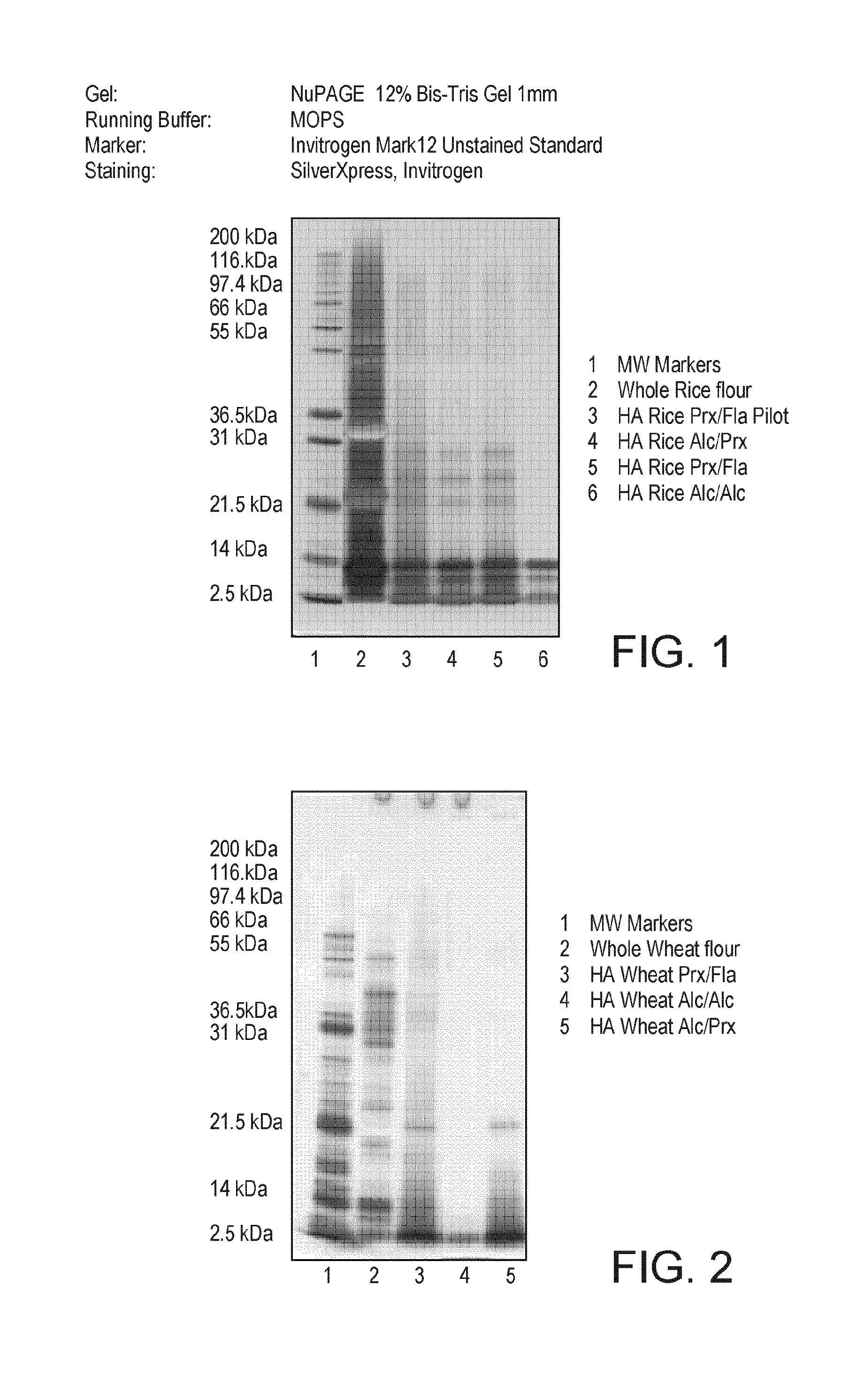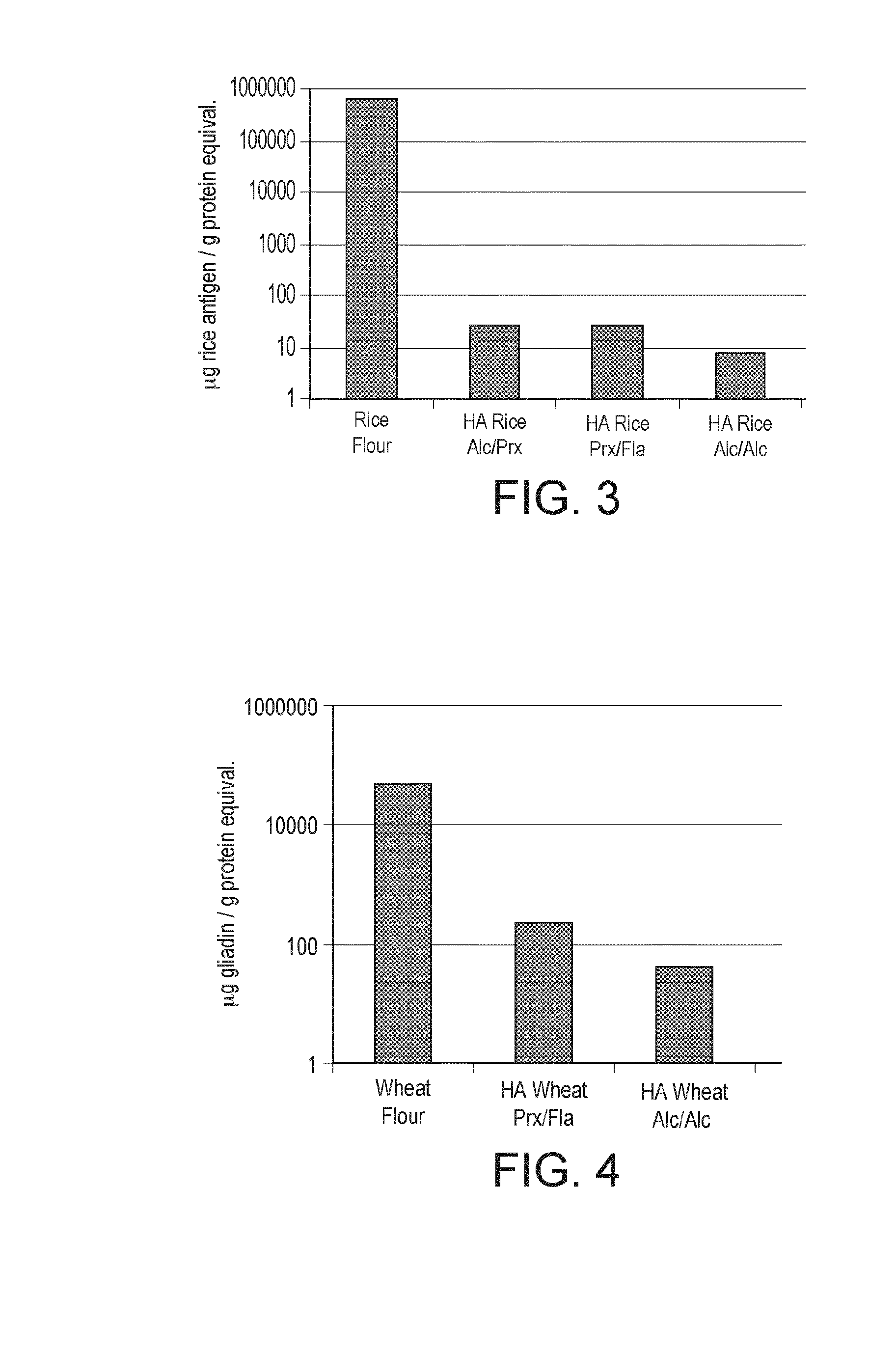Use of a hypoallergenic cereal composition for inducing specific oral tolerance
- Summary
- Abstract
- Description
- Claims
- Application Information
AI Technical Summary
Benefits of technology
Problems solved by technology
Method used
Image
Examples
example 1
[0060]10 Kg of rice flour (pre-treated according to the U.S. Pat. No. 4,374,860 to partially hydrolyse the carbohydrate content) and 23 kg of water were mixed and heated at 55° C. A solution of buffering reagent (Na(OH)2 or K(OH)2 or Ca(OH)2) was prepared and added to the mixture for pH adjustment. 5% of Protamex® enzymes (batch PW2A1006, Novozymes A / S Bagsvaerd, Denmark) was added and the mixture was maintained at 55° C. for 2 hours. After this first hydrolysis step the mixture was heated at 90° C. for 10 min. The mixture was then cooled to 55° C., 5% of Flavourzyme® 1000 L enzymes (batch 400904, Novozymes A / S Bagsvaerd, Denmark) was added and the mixture was maintained at 55° C. for 2 hours. After this second hydrolysis step, the mixture was heated at 90° C. for 30 min and then spray-dried to obtain a powder containing partially hydrolysed rice proteins with a DH of 14.2% which was conditioned in an aluminium bag.
example 2
[0061]10 Kg of rice flour (pre-treated according to the U.S. Pat. No. 4,374,860 to partially hydrolyse the carbohydrate content) and 23 kg of water were mixed and heated at 55° C. A solution of buffering reagent (Na(OH)2 or K(OH)2 or Ca(OH)2) was prepared and added to the mixture for pH adjustment (to a pH of 7.8). 10% of Alcalase®2.4L enzymes (batch 500357, Novozymes A / S Bagsvaerd, Denmark) was added and the mixture was maintained at 55° C. for 2 hours. After this first hydrolysis step the mixture was heated at 90° C. for 10 min. The mixture was then cooled to 55° C., a further 10% of Alcalase enzymes was added and the mixture was maintained at 55° C. for 2 hours. After this second hydrolysis step, the mixture was heated at 90° C. for 30 min and then spray-dried to obtain a powder containing partially hydrolysed rice proteins with a DH of 15.9% which was conditioned in an aluminium bag.
example 3
[0062]10 Kg of rice flour (pre-treated according to the U.S. Pat. No. 4,374,860 to partially hydrolyse the carbohydrate content) and 23 kg of water were mixed and heated at 55° C. A solution of buffering reagent (Na(OH)2 or K(OH)2 or Ca(OH)2) was prepared and added to the mixture for pH adjustment (pH 7.8). 5% of Alcalase®2.4L enzymes (batch 500357, Novozymes A / S Bagsvaerd, Denmark) was added and the mixture was maintained at 55° C. for 2 hours. After this first hydrolysis step the mixture was heated at 90° C. for 10 min. The mixture was then cooled to 55° C., a further 5% of Protamex® enzymes (batch PW2A1006, Novozymes A / S Bagsvaerd, Denmark) was added and the mixture was maintained at 55° C. for 2 hours. After this second hydrolysis step, the mixture was heated at 90° C. for 30 min and then spray-dried to obtain a powder containing partially hydrolysed rice proteins with a DH of 11.2% which was conditioned in an aluminium bag.
PUM
| Property | Measurement | Unit |
|---|---|---|
| Temperature | aaaaa | aaaaa |
| Fraction | aaaaa | aaaaa |
| Fraction | aaaaa | aaaaa |
Abstract
Description
Claims
Application Information
 Login to View More
Login to View More - R&D
- Intellectual Property
- Life Sciences
- Materials
- Tech Scout
- Unparalleled Data Quality
- Higher Quality Content
- 60% Fewer Hallucinations
Browse by: Latest US Patents, China's latest patents, Technical Efficacy Thesaurus, Application Domain, Technology Topic, Popular Technical Reports.
© 2025 PatSnap. All rights reserved.Legal|Privacy policy|Modern Slavery Act Transparency Statement|Sitemap|About US| Contact US: help@patsnap.com


